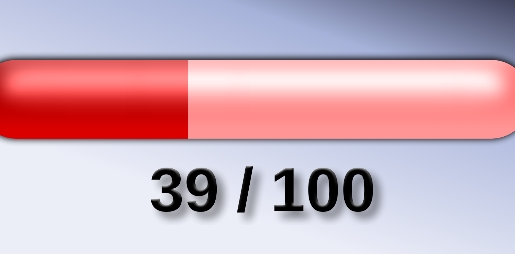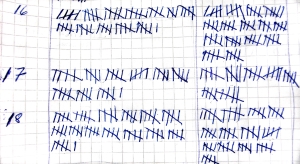
Welcome to Hit Points & Morale, the fifth and FINAL part of Alternative Encounter Building. Thank you for following and sticking with me to the end. At last we will deal with altering hit points to adjust the difficulty of your encounters.
This five-part Alternative Encounter Building series was a big part of why I put together the GM Quick Reference. I wanted an easy reference to put at the front of my GM binder. Something more useful than a GM screen, but kept me from flipping through the core rule books.
If you’re new or need a refresher, check out the previous entries before we get started.
- Alternative Encounter Building I: Challenge Rating
- Encounter Odds: Alternative Encounter Building II
- Environment Design: Alternative Encounter Building III
- Combat Readiness: Alternative Encounter Building IV
To get started we need to understand the base assumption. D&D expects the adventuring group to have 6-8 medium or harder encounters per adventuring day. Now, you don’t have to run the game very long to realize that is a LOT of encounters. A lot of encounters to both prep and run. Then, to think of how long combats can sometimes take at the table. Especially combats that have past the climax and you’re just marking off bad guy hit points.
I like the beginning of combats, before it’s evident which side is going to win. The tension and uncertainty of combat. As game masters we want more of that and fewer turns of simple hit point subtraction.
So, what happens when the game is doing something we don’t like? We change it. That’s one of the most liberating parts of running D&D.
Why don’t we change things so we have more of the exciting, early combat and less of the boring, later bit?
Here’s how we do that with the same 2d6 framework we’ve been using.
2d6 Morale/Hit Points Table
- 2 > Fights to the death
- 3-4 > Fights to 1/4 HP or 1/4 allies left
- 5-9 > Fights to 1/2 HP or 1/2 allies left
- 10-11 > Fights to 1/4 HP or 1/4 allies left
- 12 > Fights to injury
First off, you’ll notice we set the default HP assumption to half hit points. This is better for play at the table and more realistic. Most people and creatures don’t want to die. It’s basic self preservation and affects monsters as simple as oozes. If the tide of battle turns against them morale breaks. The enemy will flee, surrender to the party, or try and negotiate a truce.
Half the Hit Points = Twice the Combats
All three of those options are more interesting than chipping away at hit points and checking bodies for pocket change.

More importantly, at half HP combats take half as long. Many games I’ve played and run using full monster hit points offer 2-3 combats per session. Now, it’s easy to run five encounters in the same amount of time. Open your mind to the idea of baddie spellcasters and monsters with big, limited use abilities. More combats with those characters using their big, flashy abilities. You can put more hurt on the party. It’s about throwing more sucker punches and avoiding ten round boxing matches.
As your players get comfortable with the quick skirmish routine you can hammer them with a big fight. You can also afford to throw tougher enemies when they only have half the staying power.
But where I find it shines is the ability to characterize the monsters and NPCs. A group of soldiers that fight to 1/4 HP are battle-tested veterans. A group of wolves that fight only until injured? Well, they aren’t starving and you proved able to protect yourself. It gives a better risk/reward characterization for the battle.
All right, enough waxing about why I really like adjusting HP. Let’s make a couple encounters for a four-player party of level 15 characters. Let’s say it’s a mountainous region.
2d6 Encounter 1
- CR: @ Party level
- Odds: < 2:1 Odds
- Environment: Equal footing
- Readiness: Party unaware
- Morale: 1/2 HP/Allies
Six earth elementals fits the bill. It also makes sense they will sneak up on the party because they’re big rocks on a mountainside. I imagine them using their movement ability to charge down the side of the mountain as the party marches along. Fight around for a bit using their resistances, until they hit about 63 hit points, and then they’ll earth glide away.
2d6 Encounter 2
- CR: @ Party level
- Odds: 1:1 Odds
- Environment: Opponent favored
- Readiness: Equal awareness
- Morale: 3/4 HP/Allies

I’m thinking four medusa (medusae?). The environment is opponent favored so I think they will have four separated perches above where the party enters combat. Making them have to wind up a path and potentially split the party. This should give the medusa(e) plenty of time to fire arrows down on the PCs and attempt to petrify them. Unlike the earth elementals the medusa don’t have damage resistance. A few solid hits and they’ll make a run for it. I would also add light cover to help the medusa(e) archers armor class and dexterity saves.
There you have it. Thank you for reading. I’ve been using this encounter building system for some time and I’m glad to have the opportunity to share it with you. It has really made an impact in determining what I want in combat as a GM and player and how I play.
Check back to see what we’re talking about next time. Of course you can follow me @RedRaggedFiend on Twitter to get notices when a new post goes live. If you like my content check out my Pay-What-You-Want products on DriveThruRPG, or drop me a health potion.
